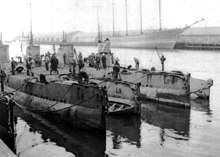USS L-6 (SS-45)
USS L-6 (SS-45) was an L-class submarine built for the United States Navy during the 1910s.
.jpg) USS L-6, possibly at the California Shipbuilding Company at Long Beach, California, in 1917. | |
| History | |
|---|---|
| Name: | USS L-6 |
| Builder: | Craig Shipbuilding Company, Long Beach, California |
| Laid down: | 27 May 1914 |
| Launched: | 31 August 1916 |
| Commissioned: | 7 December 1917 |
| Decommissioned: | 25 November 1922 |
| Fate: | Sold for scrap, 21 December 1925 |
| General characteristics | |
| Class and type: | L-class submarine |
| Displacement: |
|
| Length: | 165 ft (50 m) |
| Beam: | 14 ft 9 in (4.50 m) |
| Draft: | 13 ft 3 in (4.04 m) |
| Installed power: |
|
| Propulsion: |
|
| Speed: |
|
| Range: |
|
| Test depth: | 200 feet (61.0 m) |
| Complement: | 28 officers and enlisted men |
| Armament: |
|
Description
The L-class boats designed by Lake Torpedo Boat (L-5 through L-8) were built to slightly different specifications from the other L boats, which were designed by Electric Boat, and are sometimes considered a separate L-5 class. The Lake boats had a length of 165 feet (50.3 m) overall, a beam of 14 feet 9 inches (4.5 m) and a mean draft of 13 feet 3 inches (4.0 m). They displaced 451 long tons (458 t) on the surface and 527 long tons (535 t) submerged. The L-class submarines had a crew of 28 officers and enlisted men. They had a diving depth of 200 feet (61.0 m).[1]
For surface running, the boats were powered by two 600-brake-horsepower (447 kW) diesel engines, each driving one propeller shaft. When submerged each propeller was driven by a 400-horsepower (298 kW) electric motor. They could reach 14 knots (26 km/h; 16 mph) on the surface and 10.5 knots (19.4 km/h; 12.1 mph) underwater. On the surface, the Lake boats had a range of 5,150 nautical miles (9,540 km; 5,930 mi) at 11 knots (20 km/h; 13 mph)[1] and 150 nmi (280 km; 170 mi) at 5 knots (9.3 km/h; 5.8 mph) submerged.[2]
The boats were armed with four 18-inch (450 mm) torpedo tubes in the bow. They carried four reloads, for a total of eight torpedoes. The L-class submarines were also armed with a single 3"/50 caliber deck gun.[2]
Construction and career
L-6's keel was laid down on 27 May 1914 by Craig Shipbuilding Company in Long Beach, California. L-6 was launched on 31 August 1916 sponsored by Mrs. William R. Monroe, and commissioned on 7 December 1917 with Lieutenant H. B. Berry in command.
Service history

After exercises along the West Coast, L-6 departed Pacific waters on 20 April 1918, arriving Charleston, South Carolina, on 10 June. Following a brief overhaul, the submarine patrolled off Charleston until she sailed on 15 October for the eastern Atlantic. Arriving Ponta Delgada, Azores, in early November, L-6 joined Submarine Division 6 just prior to the signing of the Armistice with Germany on 11 November.
After making stops in Caribbean Sea and Central American ports, L-6 arrived San Pedro, California, on 14 February 1919, completing one of the best long-distance seagoing performances of the United States's youthful submarine force. From 1919 to 1922, she remained on the West Coast, experimenting with new torpedoes and undersea detection equipment. L-6 was placed in commission, in ordinary, on 24 March 1922; returned to full commission on 1 July; and sailed for the East Coast the same month. Upon arrival Hampton Roads, L-6 decommissioned on 25 November 1922, and was sold to M. Samuel and Sons on 21 December 1925 for scrapping.
Notes
- Friedman, p. 307
- Gardiner & Gray, p. 129
References
- Friedman, Norman (1995). U.S. Submarines Through 1945: An Illustrated Design History. Annapolis, Maryland: Naval Institute Press. ISBN 1-55750-263-3.
- Gardiner, Robert & Gray, Randal, eds. (1985). Conway's All the World's Fighting Ships: 1906–1921. Annapolis, Maryland: Naval Institute Press. ISBN 0-85177-245-5.
- This article incorporates text from the public domain Dictionary of American Naval Fighting Ships. The entry can be found here.
External links
- Photo gallery of USS L-6 at NavSource Naval History